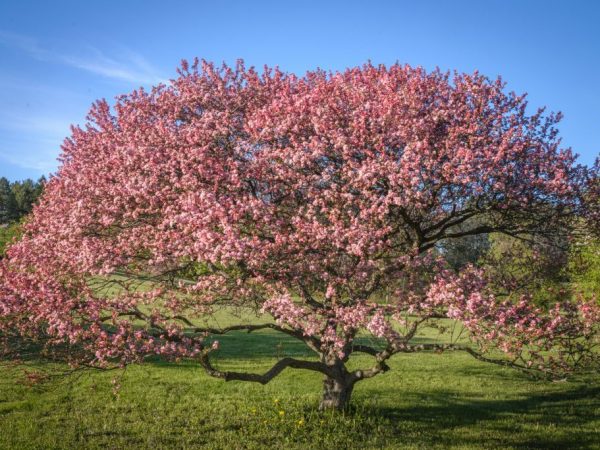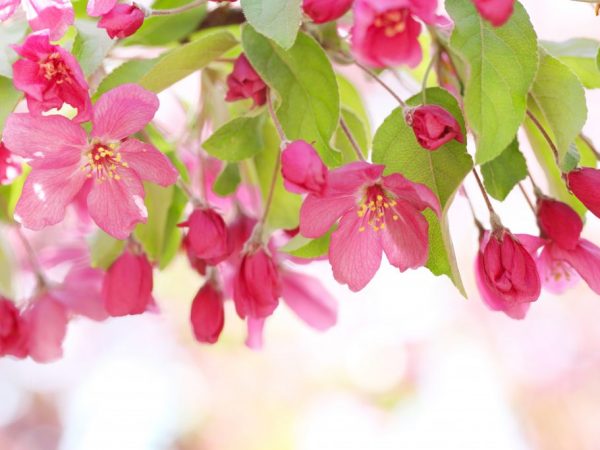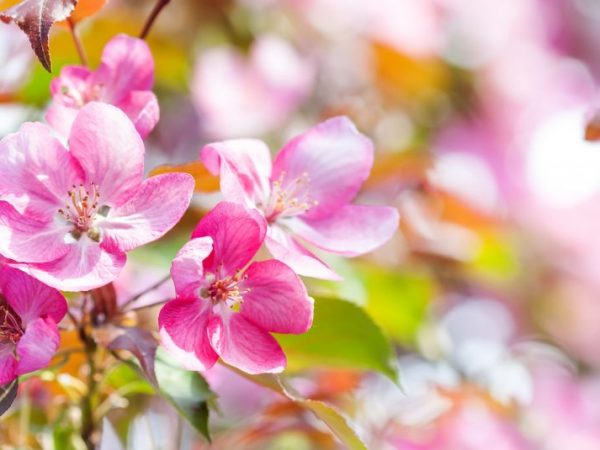Growing an ornamental apple tree
Many gardeners are convinced that a garden can only be beautiful when the trees are in bloom, but this is a wrong opinion. In the last century, an ornamental apple tree was bred, which pleases with its appearance for most of the year. Its bright leaves and unusual crown shape will not leave anyone indifferent.

Growing an ornamental apple tree
Use in landscape design
Every year, the number of ornamental apple trees and shrubs, which are characterized by purple and red leaves, increases. The highest color saturation is observed in late spring and summer. With the beginning of autumn, apple leaves darken and become more faded.
The description indicates that some apple trees turn red in the spring and take on an inviting green hue in the fall. On such crops, you need to regularly trim the crown so that young shoots do not differ from old ones.
There are some varieties of apple trees with a weeping or spherical crown. For planting, you need to choose those varieties that will grow slowly.
Due to the fact that such trees can grow under the rays of the scorching sun, they are planted as protection for other plants. Try to cultivate small amounts of red-leaved apple trees, otherwise the bright lights of the foliage will leave your garden unkempt.
An ornamental apple tree with red leaves is often used in landscaping. It is ideally compatible with green grass or a wall covered with vegetation. You can often find such cultures both in parks and on city streets.
Apple trees with decorative characteristics can be used not only in landscape design, but also to create beautiful flower bouquets.
If you decide to create your garden in Japanese style, then you can plant azaleas or bamboo next to the decorative apple tree. For a European-style garden, in addition to a tree, beech, lily, geranium or rose are ideal.
The best option for this style is tulips. This is due to the fact that the period of their flowering falls on the formation of apple blossom.
This variety looks most aesthetically pleasing in winter. It was during this period that red, orange and yellow fruits look bright against the background of white snow on the trees.
Combination with other cultures
For the colorfulness of the garden plot, it is not enough to plant several ornamental apple trees. You will need to complement them with other cultures. You need to know which plants these varieties combine best with. You can fill the voids in the garden with strawberries and other shrubs on which berries grow.
You can use fragrant tobacco, irises or daisies, but the gardener will receive the greatest aesthetic pleasure if peonies are planted between the apple trees. Both crops will be combined not only in flowering time, but also in shades of buds.
If you plant a decorative apple tree as a hedge, quince, hops, blackberries and girlish grapes will look good next to it.On the first level, you can plant lemongrass, obelisk or chaenomelis.
Popular varieties

Unusual trees are popular with designers
The John Downey variety was bred in the 19th century. The description of the variety indicates a pyramidal crown shape. The height of the tree reaches 6 m. In 1 year it grows by 30 cm. The leaves are dark green. The flowers are white and appear in May.
In September, small fruits of dark red color with a pleasant aroma are formed on the John Downey tree. In landscape design, this culture is popular.
The Brandy Magic variety grows up to 6 m. The columnar crown gives the tree an unusual appearance. In summer, the leaves acquire a rich green hue, and in autumn they turn bronze. The flowers are pink. The description of round apples indicates a small size and a yellow skin tone.
On some fruits, you can see a beautiful pale pink blush. The aroma of apples is pleasant, a bit like barberry.
Ornamental apple tree Makamik is a tree 5-7 m high with a dense crown. It is characterized by unusual purple flowers and red fruits. The tree tolerates frost well and is resistant to diseases.
Of the main characteristics of the Coccinella ornamental apple variety, the following can be distinguished:
- tree height - 4 m;
- the diameter of the conical crown reaches 3 m;
- leaves change their color depending on the season: in spring they are red, in summer they are green, and in autumn they are orange;
- double flowers of a purple hue;
- the diameter of the fruit of the Coccinella variety - 2 cm;
- apples are red with a slight overflow, small fruits stay on the tree for more than a month, the aroma of a ripe apple is sweet and pleasant.
Ornamental apple trees include the Pendula variety. The height of the tree does not exceed 4 m. The crown is weeping, umbrella-shaped. The leaves are green with a pearlescent sheen. The description of the flowers indicates a white-pink hue. You can collect honey from flowers. Pendula apples are small (up to 1 cm), yellow.
If we consider the description of the Red Sentinel variety, we can note the small height of the bush (up to 3 m). The variety blooms with pink buds. The red fruits that appear in September can hang on the tree all winter.
Ornamental apple tree Ola grows up to about 5 m, its flowers are distinguished by dark pink shades. Fruit size - about 3 cm. The culture is resistant to cold and disease.
The height of the Carmen tree is 4 m. It has a weeping crown. Abundant flowering occurs in May. The buds are pink and the leaves are red. Small fruits have a red tint, covered with a gray bloom. The apples of the variety are considered edible.
The type of decorative apple tree Everest has the following characteristics:
- the height of the tree is about 4 m;
- the crown is columnar;
- flowers are white with pink spots;
- leaves are large, dark green;
- the fruit of the apple tree is orange with a slight red blush.
If we consider the Helena variety, the height of the tree reaches 3 m. The leaves of the variety are large, burgundy. The compact tree blooms in April, producing purple flowers. Small yellow fruits of the Helena variety can be used both fresh and canned.

Ornamental apple trees decorate the garden
The Profusion variety is characterized by strong growth, the height of the tree can exceed 6 m. Throughout the year, the leaves change their color from red to dark brown. Flowers change their color depending on the care and climate. You can find both red or pink and purple buds. The fruits reach a maximum diameter of 20 mm.
Reproduction of apple trees
Experienced gardeners know the best methods to propagate ornamental apple trees. The description indicates that this is best done with a kidney-assisted vaccination.
It is undesirable to propagate such crops by seeds. This is due to the fact that subsequently, young seedlings may lack decorative qualities. They can not always inherit the beauty of their “progenitors”.
Landing
In order for flowering and fruiting to begin at a certain time and last longer, planting should be carried out in sunny areas. The soil should be fertile and not waterlogged. The more moisture there is in the roots, the greater the risk of rotting. Waterlogged soil results in faded and delayed flowering.
Beautiful apple trees grow best in the Moscow region.
Planting is carried out in early spring with the help of seedlings. In this case, you need to use a 5x5 m scheme. Frequent planting leads to the fact that the survival rate of the culture falls.
Planting an apple tree consists of several stages:
- prepare the seat by digging it up;
- make a hole 60 cm in diameter. The depth of the planting hole should be 80 cm;
- pour a little superphosphate (about 100 g) and 4 kg of humus into it;
- place a seedling in the hole and sprinkle it with earth;
- pour 30 liters of water over the culture. After that, the trunk circle is mulched.
Care features
Because seedlings need high-quality watering and feeding, you need to know the basic principles of caring for them. You need to water young ornamental apple trees once a week, spending 10 liters of water for each tree. Use warm boiled water to avoid clogging the soil.
Mature trees do not need additional watering. Natural precipitation is enough for them. Top dressing should be alternated. In the first month, add 3 kg of humus and 1 kg of peat under the tree. On the second - use already 400 g of superphosphate or ammonium nitrate.
Remove weeds and fallen leaves in a timely manner so that parasites do not start there. During preventive pruning, dry, broken, or diseased branches should be removed. The formation of the crown is carried out in urgent need and at the request of the gardener.
Despite the resistance of such apples to diseases, signs of powdery mildew and scab often appear on their surface. Spraying with Bordeaux liquid (20 g of the product per 3 liters of water) will help to fight such diseases. If you notice signs of aphid exposure, you need to urgently spray the apple tree with a solution of copper sulfate (50 g per 2 liters of water).
The use of bright and unusual apple crops is justified by the beauty of the trees, which will create an amazing atmosphere in the garden. The price of seedlings is low - about 200 rubles. The advantage of such crops is that they are unpretentious in care and planting.

